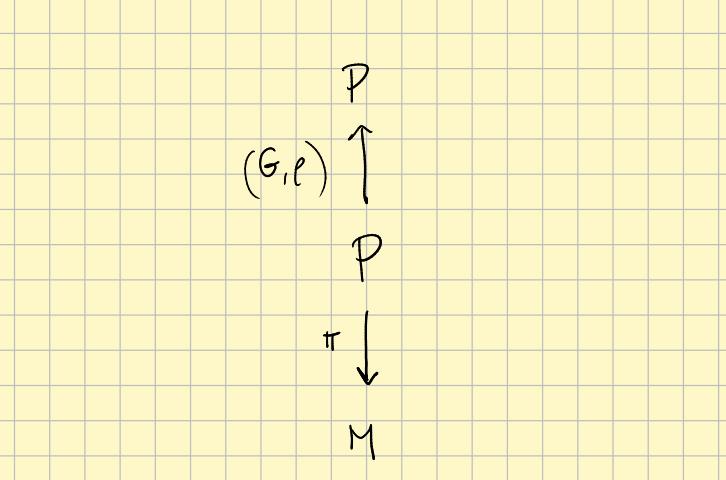Principal bundles
First approach
Definition and remarks
We come from the context G-bundles.
Given a G-bundle $P\stackrel{\pi}{\rightarrow} M$ we will call it a principal $G$-bundle if the standard fibre is $S=G$ and there exists a free right action $\rho$ of $G$ on $P$ such that
- The orbits of $\rho$ are the fibres of $P$.
- For every local trivialization
we have that for every $m\in U$ and $h,g\in G$
$$ \tilde{\psi}(m)(hg)=\rho(\tilde{\psi}(m)(h),g) $$Observe that this is equivalent to saying that we have a fibrewise right action of $G$ over $P$ that is free and transitive over each fibre. Each fibre is, then, a G-torsor. We will use indistinctly the notations $\rho_g(p)=\rho(p,g)=pg=R_g(p)$ when needed for clarity.
We will write

Infinitesimal behavior of the right action
Let $P$ be a right principal $G$-bundle over a smooth manifold $M$, and let $\pi: P \rightarrow M$ be the projection map. Let $R_g: P \rightarrow P$ denote the right action of the group $G$ on $P$, defined by $R_g(p) = p \cdot g$ for $p \in P$ and $g \in G$.
We consider the differential of the projection map, denoted $d\pi: TP \rightarrow TM$, which is a linear map between the tangent spaces at corresponding points. Moreover, let $(R_g)_*: TP \rightarrow TP$ be the pushforward (differential) of $R_g$.
The behavior of $d\pi$ with respect to $(R_g)_*$ is characterized by the following commutative diagram:
$$ \begin{array}{ccc} TP & \xrightarrow{(R_g)_*} & TP \\ \downarrow d\pi & & \downarrow d\pi \\ TM & = & TM \end{array} $$This means that for each $v \in TP$, the following equation holds:
$$ d\pi \circ (R_g)_* (v) = d\pi(v) $$In a specific point $p$
$$ d\pi_p \circ (R_g)_* (v) = d\pi_{pg^{-1}}(v) $$This commutative property encapsulates the equivariance of $d\pi$ under the right $G$-action and indicates that the differential $d\pi$ is essentially "constant" along the $G$-orbits in $P$.
Alternative approach
Given a G-bundle $E\to M$ with standard fibre $S$, the associated principal $G$-bundle $P$ is, in a sense, a generalized frame bundle for the original bundle. To see this, observe that the principal $G$-bundle can be obtained in the following way. Given a trivializing atlas $\{(U_{\alpha},\phi_{\alpha})\}$ of $E$, we can define for every $m\in M$ the set
$$ P_m:=\{\tilde{\phi}_{\alpha}(m) \circ g: \alpha \text{ such that }m\in U_{\alpha}, g\in G\} $$Their elements are the different ways of express the fibre $E_m$ (maybe an "uncomfortable" space) in terms of the standard fibre $S$ (a "comfortable space), "preserving" the structure provided by $G$. We can call them the $G$-bases for $E_m$ (when $E_m$ is a vector space, $S$ is $\mathbb{R}^n$ and $G=GL(n)$ the set $P_m$ is made of the different basis of $E_m$ . See the note basis and change of basis).
Observe that for $m\in U_{\alpha\beta}$ it could happen
$$ \tilde{\phi}_{\alpha}(m) \circ g=\tilde{\phi}_{\beta}(m) \circ g'\in P_m $$and then must be $g=g_{\alpha\beta}(m) g'.$
So if we consider the space
$$ P=\bigsqcup_{m\in M} P_m $$we can provide maps
$$ \begin{array}{cccc} \psi_{\alpha}:&U_{\alpha}\times G & \longrightarrow & P\\ & (m,g) &\longmapsto & \tilde{\phi}_{\alpha}(m) \circ g \end{array} $$such that it can be proven that $P$ is a principal $G$-bundle with atlas $\{(U_{\alpha},\Psi_{\alpha})\}$.
(It can be proven with the final topology and the fact of $G$ being a Lie group...)
Components of a section
Thus, given a G-bundle and its associated principal $G$-bundle constructed in this way, we can define the components of $v\in E_m$ with respect to any $\phi \in P_m$:
$$ \phi^{-1}(v)\in S. $$Then, any local section of $P$ can be called a $G$-frame, and therefore every local trivialization $(U,\psi)$ is equivalent to a distinguished $G$-frame:
$$ p(m)=\psi(m,e), \text{ for } m\in U $$and $e$ being the identity in $G$.
In some context they are called moving frames or choice of a gauge. In case that the G-bundle $E$ is the tangent bundle of the manifold, the concept of $G$-frame is the usual frame.
Trivializations vs sections
The orbit of $G$ at $p\in P$ is just the fiber $\pi^{-1}(\pi(p))$ and, moreover, $\pi^{-1}(\pi(p))\cong G$. We can imagine $\pi^{-1}(\pi(p))$ like $G$ but without a ditinguished point $e$. For example, a circle bundle ($G=S^1=\{e^{i\cdot t}\}$) has a fiber wich could be rotated but no point is matched with the identity. That is, every fiber is a $G$-torsor or principal homogeneous space.
In this context we can speak of the translation map (or gauge transformation)
$$ \tau :\pi^{-1}(\pi(p)) \times \pi^{-1}(\pi(p)) \rightarrow G. $$Given $q, q' \in \pi^{-1}(\pi(p)),$ since the action is free, there exist one and only one $\tau(p,p')\in G$ such that
$$ p'=p\cdot \tau(p,p') $$and we will write $p^{-1}p'=\tau(p,p')$. Think of it like the subtraction of points in affine space.
Proposition
Local sections of a $G$-principal bundle are in one to one correspondence with local trivializations.$\blacksquare$
Proof
The idea is that sections mark a distinguished point in every fiber. Then it only rest to use the translation function defined above. $\blacksquare$
It turns out that a $G$-principal bundle is trivial if and only if has a global section.
Connections
A fundamental idea is that of a principal connection on a principal bundle.
Group reduction
See extension and reduction of a principal bundle
________________________________________
________________________________________
________________________________________
Author of the notes: Antonio J. Pan-Collantes
INDEX: